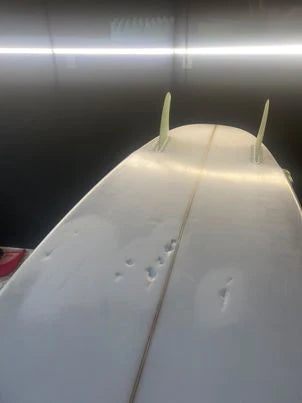
DIY Surfboard Crack Repair: When to Do It Yourself and When to Seek Professional Help
Surfboards, like any other equipment, undergo wear and tear, especially when braving the waves. Cracks can be a common issue, affecting both the performance and safety of your board. While some cracks may seem minor and manageable for a DIY fix, others might require professional expertise. Understanding when to take matters into your own hands and when to seek professional help is crucial for maintaining your board's integrity. Let's dive into the factors to consider:
Assessing the Damage
The first step is assessing the extent of the damage. Here are some guidelines to determine whether you can handle the repair yourself:
DIY-Friendly Cracks:
Hairline cracks or small dings: These minor imperfections are usually easy to manage with DIY repair kits available in the market.
Surface scratches: Light scratches on the surface might not affect the board's structural integrity and can be fixed with minimal effort.
Minor dents: Shallow dents that haven't penetrated deep into the board's core might be manageable with DIY techniques.
When to Seek Professional Help:
Deep or extensive cracks: Cracks that are deep, long, or compromising the board's structure should be handled by professionals to ensure a thorough and lasting repair.
Damage near the fin box or leash plug: Repairs in critical areas like these require precision and expertise to maintain the board's functionality.
Complex damage: If the damage involves multiple issues or complex fractures, it's best to entrust the repair to professionals who have experience dealing with such cases.
DIY Repair Techniques
For those confident in their abilities, DIY repair kits and techniques can be handy for minor fixes:
Epoxy Repair Kits: These kits often contain resin, hardener, fiberglass cloth, and instructions for patching small cracks and dings.
Sun Cure Resin: Ideal for quick fixes, this resin hardens under the sun and works well for small dings and scratches.
Sanding and Polishing: After applying the necessary repair materials, sanding and polishing can help blend the repair seamlessly with the board's surface.
Why Professional Help Matters
Professional repair services offer several advantages:
Expertise and Experience: Professionals possess the skills and experience to handle complex repairs efficiently, ensuring the board's structural integrity.
Specialized Tools and Materials: Repair shops have access to high-quality materials and specialized tools that might not be readily available for DIY repairs.
Guaranteed Quality: Most repair shops provide warranties or guarantees for their work, giving you peace of mind regarding the repair's quality and durability.
Conclusion
Knowing when to tackle surfboard repairs yourself and when to seek professional assistance is essential for maintaining your board's performance and longevity. While minor issues can often be handled at home with DIY kits, complex or critical damage demands the expertise of professionals. Prioritize the safety and functionality of your board by making informed decisions about repair solutions. When in doubt, it's never a bad idea to consult with a professional repair service to ensure your beloved board receives the care it deserves.
Remember, whether you choose a DIY approach or professional help, timely repairs can extend the lifespan of your surfboard, allowing you to catch many more waves in the future!
